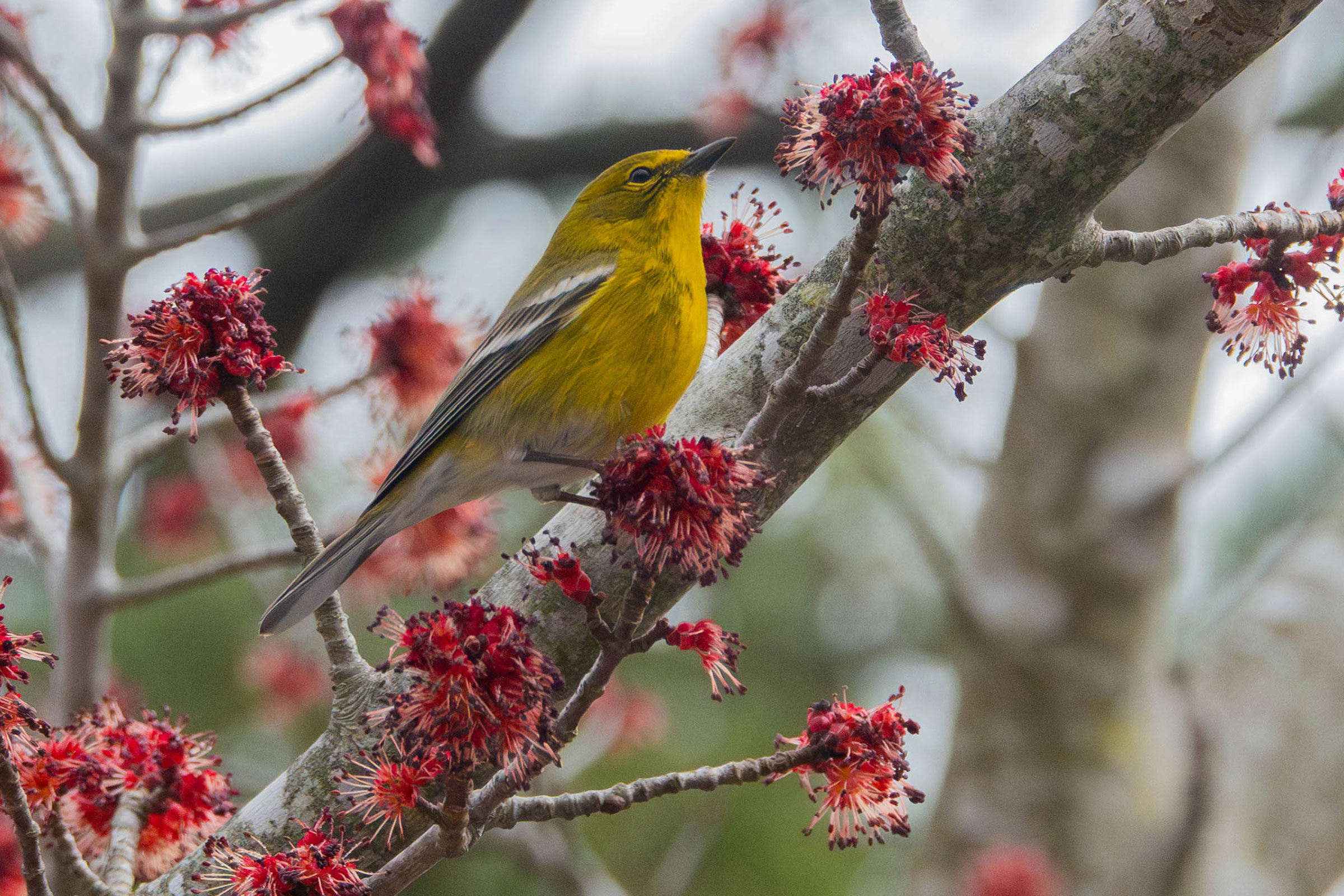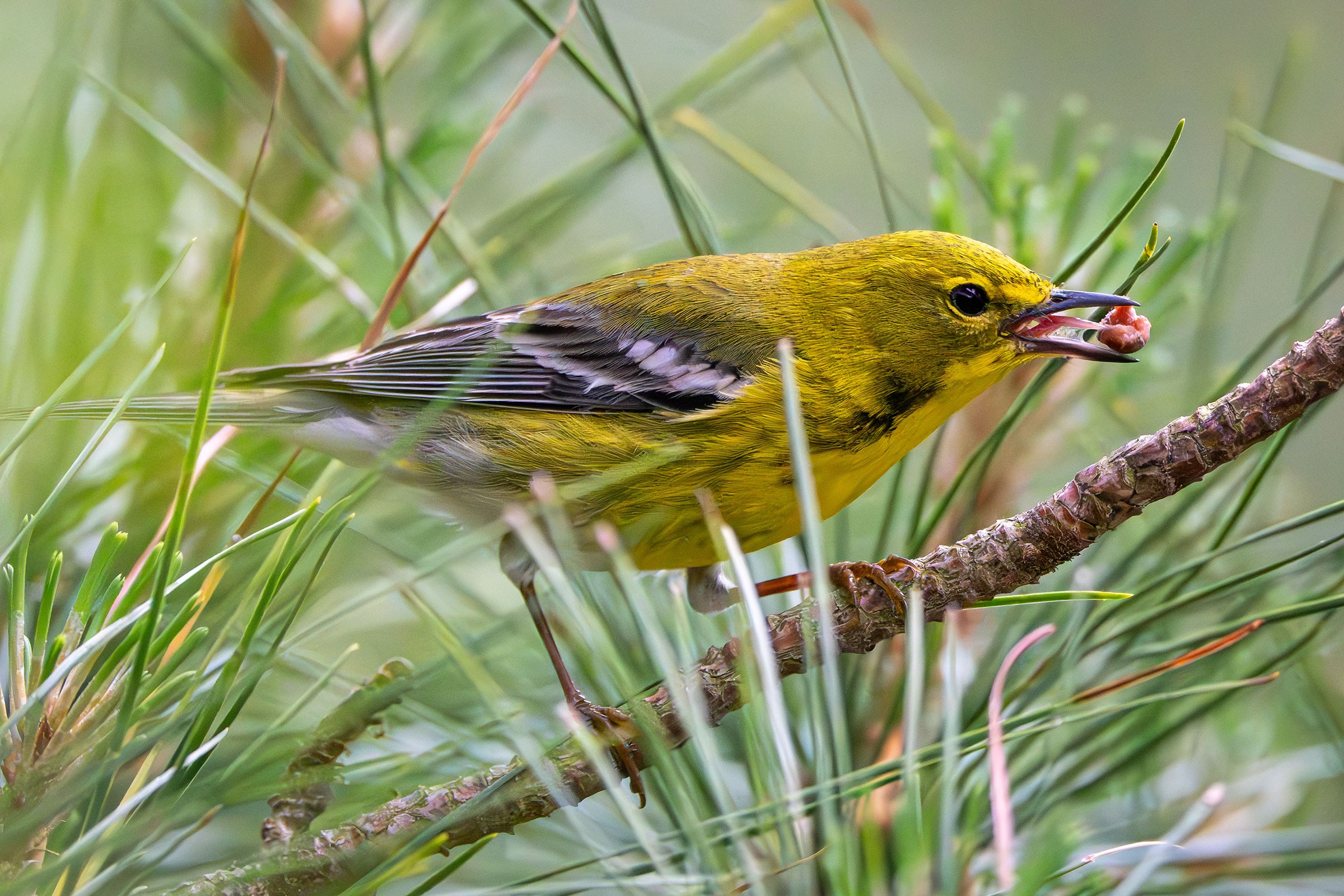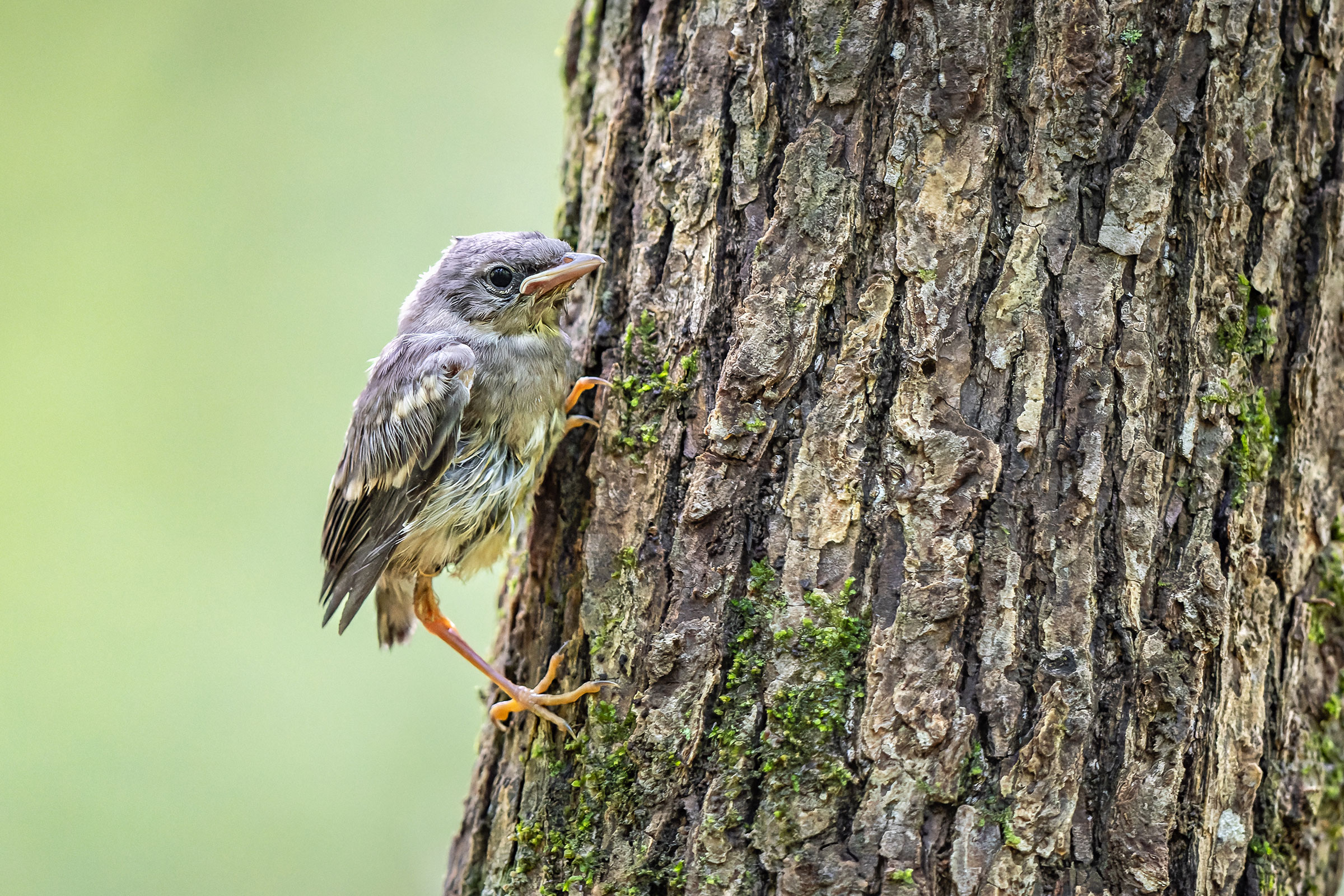Introduction
The Pine Warbler is one of only a few warblers that remain in the U.S. throughout the year and do not migrate to countries further south. In fact, Pine Warblers are year-round residents in some portions of southern Virginia, where they can be observed flitting through pine stands. In summer, they eat caterpillars and other arthropods, such as beetles, ants, and spiders. When those foods are not available, they readily eat seeds from pines and other plants. Interestingly, two of their favorite seed-based foods are Virginia pine (Pinus virginiana) and Virginia creeper (Parthenocissus quinquefolia) (Rodewald et al. 2020).
Breeding Distribution
Pine Warblers are distributed throughout Virginia, but they are most likely to occur in pine forests in the central and southern Piedmont region and in the Coastal Plain region (Figure 1). In the Mountains and Valleys region, occurrence is lower overall and more variable, except in the southwestern corner, where they are often found in pine plantations (Rottenborn and Brinkley 2007). They are generally absent in the valleys that are dominated by agricultural and in developed areas.
Between the First and Second Atlases (Figures 1 and 2), the change in the Pine Warbler’s likelihood of occurrence was minimal with some decreases in the Northern Virginia area and southern portion of the Mountains and Valleys region (Figure 3). A slight increase probable occurrence occurred in the southern portion of the Coastal Plain in the Great Dismal Swamp area.

Figure 1: Pine Warbler breeding distribution based on probability of occurrence (Second Atlas, 2016–2020). This map indicates the probability that this species will occur in an Atlas block (an approximately 10 mi2 [26 km2] survey unit) based on environmental (including habitat) factors and after adjusting for the probability of detection (variation in survey effort among blocks).

Figure 2: Pine Warbler breeding distribution based on probability of occurrence (First Atlas, 1985–1989). This map indicates the probability that this species will occur in an Atlas block (an approximately 10 mi2 [26 km2] survey unit) based on environmental (including habitat) factors and after adjusting for the probability of detection (variation in survey effort among blocks). Blocks in white were not surveyed during the First Atlas and were not modeled.

Figure 3: Pine Warbler change in breeding distribution between Atlases (1985–1989 and 2016–2020) based on probability of occurrence. This map indicates the change in the probability that this species will occur in a block (an approximately 10 mi2 [26 km2] survey unit) between Atlas periods. Blocks with no change may have constant presence or constant absence. Blocks in white were not surveyed during the First Atlas and were not modeled.
Breeding Evidence
Pine Warblers were confirmed breeders in 267 blocks and 86 counties and probable breeders in 16 additional counties (Figure 4). Additionally, the distribution of breeding evidence observations was similar between the First and Second Atlases (Figures 4 and 5).
The earliest breeding confirmations were recorded in early and mid-March, when adults were observed nest building and carrying nesting material. Throughout the breeding season, confirmations were recorded primarily based on observations of adults carrying food (April 9 – July 27), adults feeding young (May 4 – August 10), and recently fledged young (May 13 – August 14) (Figure 6).
For more general information on the breeding habits of this species, please refer to All About Birds.
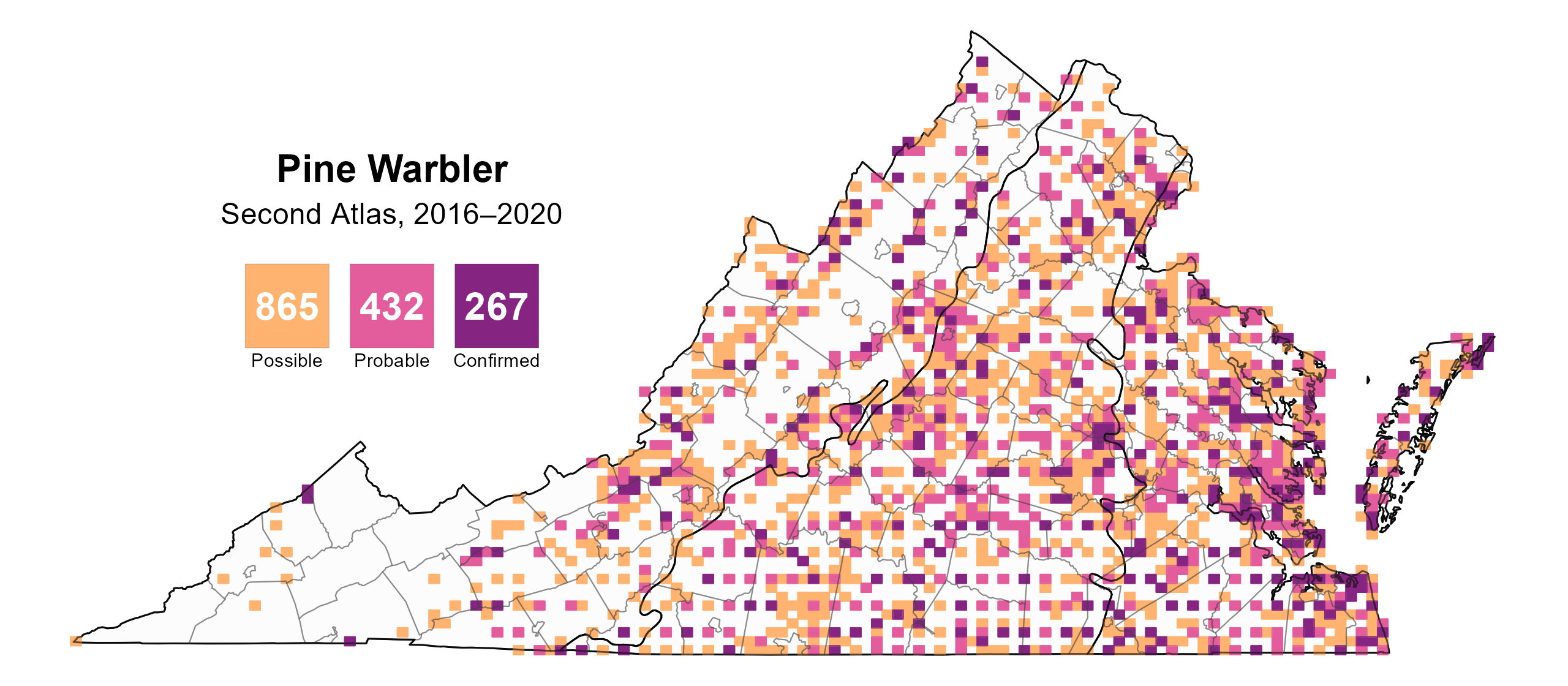
Figure 4: Pine Warbler breeding observations from the Second Atlas (2016–2020). The colored boxes illustrate Atlas blocks (approximately 10 mi2 [26 km2] survey units) where the species was detected. The colors show the highest breeding category recorded in a block. The numbers within the colors in the legend correspond to the number of blocks with that breeding evidence category.
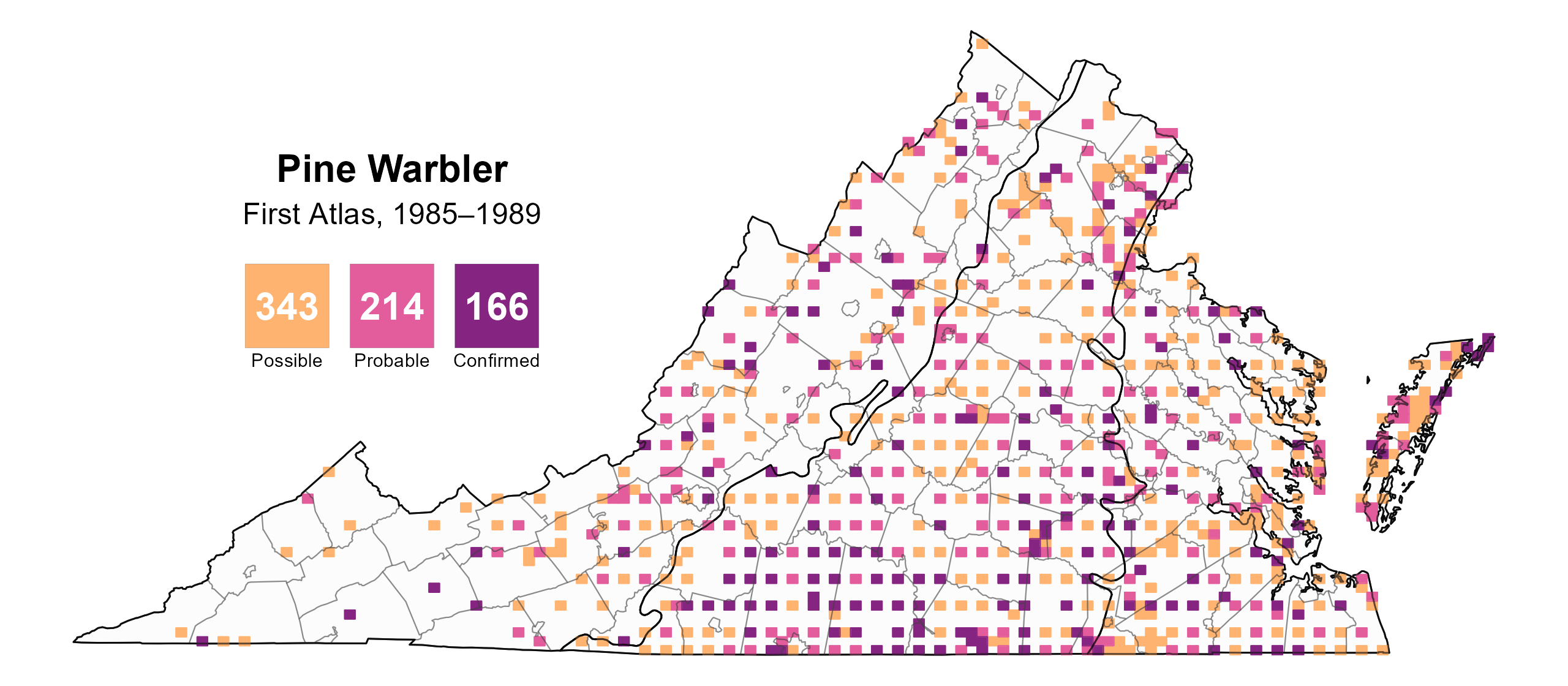
Figure 5: Pine Warbler breeding observations from the First Atlas (1985–1989). The colored boxes illustrate Atlas blocks (approximately 10 mi2 [26 km2] survey units) where the species was detected. The colors show the highest breeding category recorded in a block. The numbers within the colors in the legend correspond to the number of blocks with that breeding evidence category.

Figure 6: Pine Warbler phenology: confirmed breeding codes. This graph shows a timeline of confirmed breeding behaviors. Tick marks represent individual observations of the behavior.
Population Status
Pine Warbler relative abundance was estimated to be highest in the forested areas of the Coastal Plain and Piedmont regions (Figure 7). In the Piedmont region, abundance was lower in the northern and southwestern sections and the highly developed area around Richmond. Abundance in the Mountains and Valleys region was generally low and variable, with some areas of moderate abundance where coniferous forest is present.
The total estimated Pine Warbler population in the state is approximately 442,000 individuals (with a range between 334,000 and 588,000). Based on the North American Breeding Bird Survey (BBS), the Pine Warbler population increased by a significant 1.54% annually from 1966–2022 in Virginia, and between Atlases, its population remained stable, experiencing a nonsignificant increase of 0.42% per year from 1987–2018 (Hostetler et al. 2023; Figure 8).

Figure 7: Pine Warbler relative abundance (Second Atlas, 2016–2020). This map indicates the predicted abundance of this species at a 0.4 mi2 (1 km2) scale based on environmental (including habitat) factors. Abundance values are presented on a relative scale of low to high.

Figure 8: Pine Warbler population trend for Virginia as estimated by the North American Breeding Bird Survey. The vertical axis shows species abundance; the horizontal axis shows the year. The solid line indicates the estimated population trend; there is a 97.5% probability that the true population trend falls between the dashed lines. The shaded bars indicate the First and Second Atlas periods.
Conservation
Pine Warblers are common and stable in Virginia and throughout their range (Rodewald et al. 2020). They are not considered a species of special concern, and no specific conservation projects are underway in Virginia.
Interactive Map
The interactive map contains up to six Atlas layers (probability of occurrence for the First and Second Atlases, change in probability of occurrence between Atlases, breeding evidence for the First and Second Atlases, and abundance for the Second Atlas) that can be viewed one at a time. To view an Atlas map layer, mouse over the layer box in the upper left. County lines and physiographic regional boundaries (Mountains and Valleys, Piedmont, and Coastal Plain) can be turned on and off by checking or unchecking the box below the layer box. Within the map window, users can hover on a block to see its value for each layer and pan and zoom to see roads, towns, and other features of interest that are visible beneath a selected layer.
View Interactive Map in Full Screen
References
Hostetler, J. A., J. R. Sauer, J. E. Hines, D. Ziolkowski, and M. Lutmerding (2023). The North American breeding bird survey, analysis results 1966–2022. U.S. Geological Survey, Laurel, MD, USA. https://doi.org/10.5066/P9SC7T11.
Rodewald, P. G., J. H. Withgott, and K. G. Smith (2020). Pine Warbler (Setophaga pinus), version 1.0. In Birds of the World (A. F. Poole, Editor). Cornell Lab of Ornithology, Ithaca, NY, USA. https://doi.org/10.2173/bow.pinwar.01.
Rottenborn, S. C., and E. S. Brinkley (Editors) (2007). Virginia’s birdlife: An annotated checklist. 4th edition. Virginia Society of Ornithology.

